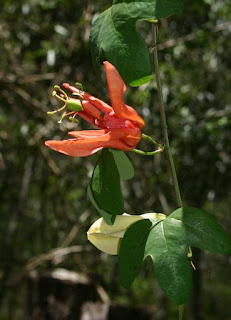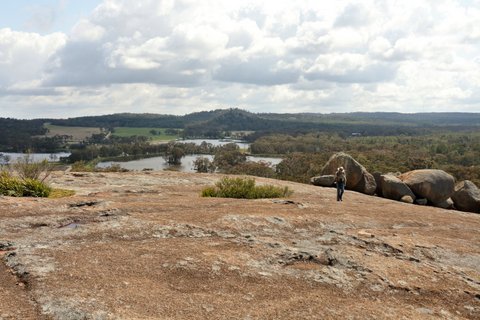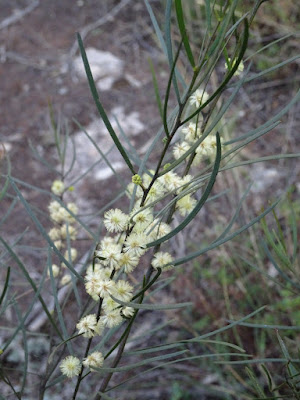The Toowoomba Field Naturalists Club Inc. would like to respectfully acknowledge the Jarowair people, Traditional Custodians, of the Coalbank area on which our outing took place, and pay our respects to both the past and present first peoples, their elders, languages, customs, culture and connection to this wonderful country.
 |
| Morning tea in fine spring weather Photo: L. Moodie |
It was a bright sunny morning when members wended their way to Coalbank, A talk by the current owners was given during morning tea. The land (about 350 acres or 142 ha) was bought about fifteen years ago, when it was a dairy farm. The talk included an outline of some of their philosophy that underpins what they do on this property, e.g., every plant has its place, just need to find out where. One principle: anything cut, went back into the earth as mulch.
 |
| Red Passion Flower Passiflora aurantia Photo: T, Gardner |
Then it was time to explore an area near a scree slope. (See more information about screes at the end of this report.) An Orange Olive Plum Elaeodendron australe var. integrifolium but no fruit at the moment caught some members' attention. There was also a lot of yellow-flowering Spur Goodenia Goodenia paradoxa covering a lot of the ground. A flowering native passion vine Passiflora aurantia var. aurantia which had both its pink/reddish flowers as well as some green fruit was admired. There were also some weeds that we noted: the Spear Thistles and Lantana.
 |
| Warrigal Greens Tetragona tetragoinoides Photo: T, Gardner |
After lunch members explored the creek, disturbing a Lace Monitor Varanus varius, which dashed up a tree.
All in all, an outing in which the weather made it a very pleasant, late spring excursion.
T
On the Range from Toowoomba to the Bunya Mountains there are remnants of the many basalt flows mostly as hill caps. The basalts, some coarse and blocky some flowbanded and more finely layered, are mostly harder than the underlying sediments.
During weathering, the softer underlying rocks erode more easily leaving the basalt with steep, cliff like outcrops near the hilltops. As the basalt breaks and collapses down the slope a cover of basaltic fragments. sometimes as scree, forms over the eroding sediments.
scree (skrē) n. 1. Loose rock debris covering a slope.
The term scree is applied both to an unstable steep mountain slope composed of rock fragments and other debris, and to the mixture of rock fragments and debris itself. The term scree is sometimes used more broadly for any sheet of loose rock fragments mantling a slope.
 |
| The scree slope Photo: D. Johnstone |
 |
| Lace Monitor Varanus varius Photo: D. Johnstone |
Species Lists
Frogs: Beeping Froglet Crinia parinsignifera, Spotted Grass Frog Limnodynastes amanuenses, Slender Bleating Treefrog Litoria balatus, Emerald Spotted Treefrog Litoria peronii
Birds: Plumed Whistling-Duck, Crested Pigeon, Bar-shouldered Dove, White-faced Heron, Black-shouldered Kite, Galah, Sulphur-crested Cockatoo, Rainbow Lorikeet, Scaly-breasted Lorikeet, Australian King Parrot, Pale-headed Rosella (southern form), Pheasant Coucal, Eastern Koel, Laughing Kookaburra, Superb Fairy-wren, Striated Pardalote, Lewin’s Honeyeater, Noisy Miner, Spiny-cheeked Honeyeater, Brown Honeyeater, Noisy Friarbird, Striped Honeyeater, Grey-crowned Babbler (eastern), Eastern Whipbird, Australasian Figbird, Olive-backed Oriole, Grey Butcherbird, Australian Magpie, Pied Currawong (eastern Australia), Willie Wagtail (southern), Torresian Crow, Apostlebird, Welcome Swallow
Land Snails: Nomadic Velvet Snail Neveritis aridorum
Spiders: Speckled Orbweaver Araneus circulissparsus, a flower spider Boomerangia dimidiata, wrap-around spiders Dolophones conifera and Dolophones turrigera, Garden Orb-weaver Hortophora transmarina, Dotty Lynx Spider Oxyopes punctatus, Variable Lynx Spider Oxyopes variabilis, Octopus Crab Spider Tmarus marmoreus
 |
| Boomerangiana dimidiata Photo: G. Walter |
 |
| Cattle Poison Sawfly Lophyrotoma interrupta Photo: G. Walter |
Dragonflies and Damselflies: Wandering Ringtail Austrolestes leda, Wandering Percher Diplacodes bipunctata, Scarlet Percher Diplacodes haematodes, Tau Emerald Hemicordulia tau
Other Invertebrates: Beetles; Yellow Soldier Beetle Chauliognathus flavipennis, a longicorn beetle Corrhenes paulla, a weevil Rhinotia sp. (possibly a Long-nosed Weevil Rhinotia hemisticta), Bugs; Ricespotting Bug Eysarcoris distinctus, Cicadas; Bark Squeaker Atrapsalta corticina. Flies & Mosquitoes; Scotch Grey Mosquito Aedes alternans, Ants & Sawflies; Cattle Poison Sawfly Lophyrotoma interrupta, Giant Bull Ant Myrmecia brevinoda.
Flora discussed or taken note of on the day (not a comprehensive list):
Vines, Scramblers & Climbers: Red-flowering Passionfruit Passiflora aurantia,
Trees: Narrow-leaved Red Olive Plum or Orange Olive Plum Elaeodendron australe var. integrifolium, Forest Red Gum Eucalyptus tereticornis, Native
Cherry or Cherry Ballart Exocarpos cupressiformis.
 |
| A Weevil - Rhinotia species Photo: G. Walter |



































